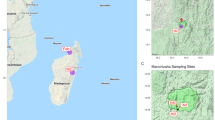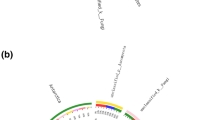Abstract
Studying fungal diversity is vital if we want to shed light on terrestrial ecosystem functioning. However, there is still poor understanding of fungal diversity and variation given that Fungi are highly diversified and that most of fungal species remain uncultured. In this study we explored diversity with 454 FLX sequencing technology by using the Internal Transcribed Spacer 1 (ITS1) as the fungal barcode marker in order to evaluate the effect of 11 environmental conditions on alpine soil fungal diversity, as well as the consistency of those results by taking into account rare or unidentified Molecular Operational Taxonomic Units (MOTUs). In total we obtained 205131 ITS1 reads corresponding to an estimated fungal gamma diversity of between 5100 and 12 000 MOTUs at a 98% similarity threshold when considering respectively only identified fungal and all MOTUs. Fungal beta-diversity patterns were significantly explained by the environmental conditions, and were very consistent for abundant/rare and fungal/unidentified MOTUs confirming the ecological significance of rare/unidentified MOTUs, and therefore the existence of a fungal rare biosphere. This study shows that a beta-diversity estimation based on pyrosequencing is robust enough to support ecological studies. Additionally, our results suggest that rare MOTUs harbour ecological information. Thus the fungal rare biosphere may be important for ecosystem dynamics and resilience.




Similar content being viewed by others
References
Amend AS, Seifert KA, Samson R, Bruns TD (2010) Indoor fungal composition is geographically patterned and more diverse in temperate zones than in the tropics. Proc Natl Acad Sci USA 107:13748–13753
Anderson MJ (2001) A new method for non-parametric multivariate analysis of variance. Aust Ecol 26:32–46
Bellemain E, Carlsen T, Brochmann C, Coissac E, Taberlet P, Kauserud H (2010) ITS as an environmental DNA barcode for fungi: an in silico approach reveals potential PCR biases. BMC Microbiol 10:189
Berg G, Smalla K (2009) Plant species and soil type cooperatively shape the structure and function of microbial communities in the rhizosphere. FEMS Microbiol Ecol 68:1–13
Bergero R, Girlanda M, Bello F, Luppi AM, Perotto S (2003) Soil persistence and biodiversity of ericoid mycorrhizal fungi in the absence of the host plant in a Mediterranean ecosystem. Mycorrhiza 13:69–75
Bills GF, Christensen M, Powell M, Thorn G (2004) Saprobic soil fungi. In: Mueller GM, Bills GF, Foster MS (eds) Biodiversity of fungi: inventory and monitoring methods. Academic Press, p 777 pages
Bissett J, Parkinson D (1979) Distribution of fungi in some alpine soils. Can J Bot 57:1609–1629
Buée M, Reich M, Murat C, Morin E, Nilsson RH, Uroz S, Martin F (2009) 454 Pyrosequencing analyses of forest soils reveal an unexpectedly high fungal diversity. New Phytol 184:449–456
Choler P, Michalet R (2002) Niche differentiation and distribution of Carex curvula along a bioclimatic gradient in the southwestern Alps. J Veg Sci 13:851–858
Christensen M (1989) A View of Fungal Ecology. Mycologia 81:1–19
Cochrane G, Akhtar R, Bonfield J et al (2009) Petabyte-scale innovations at the European Nucleotide Archive. Nucleic Acids Res 37:D19–D25
De Deyn GB, Van der Putten WH (2005) Linking aboveground and belowground diversity. Trends Ecol Evol 20:625–633
Ettema CH, Wardle DA (2002) Spatial soil ecology. Trends Ecol Evol 17:177–183
Fröhlich-Nowoisky J, Pickersgill DA, Despres VR, Poschl U (2009) High diversity of fungi in air particulate matter. Proc Natl Acad Sci USA 106:12814–12819
Galand PE, Casamayor EO, Kirchman DL, Lovejoy C (2009) Ecology of the rare microbial biosphere of the Arctic Ocean. Proc Natl Acad Sci USA 106:22427–22432
Green JL, Holmes AJ, Westoby M, Oliver I, Briscoe D, Dangerfield M, Gillings M, Beattie AJ (2004) Spatial scaling of microbial eukaryote diversity. Nature 432:747–750
Hawksworth DL (2001) The magnitude of fungal diversity: the 1.5 million species estimate revisited. Mycol Res 105:1422–1432
Huber JA, Mark Welch DB, Morrison HG, Huse SM, Neal PR, Butterfield DA, Sogin ML (2007) Microbial population structures in the deep marine biosphere. Science 318:97–100
Huse SM, Huber JA, Morrison HG, Sogin ML, Welch DM (2007) Accuracy and quality of massively parallel DNA pyrosequencing. Genome Biol 8:R143
Huse SM, Welch DM, Morrison HG, Sogin ML (2010) Ironing out the wrinkles in the rare biosphere through improved OTU clustering. Environ Microbiol 12:1889–1898
Jumpponen A, Jones K (2009) Massively parallel 454 sequencing indicates hyperdiverse fungal communities in temperate Quercus macrocarpa phyllosphere. New Phytol 438–448
Jumpponen A, Jones KL, David Mattox J, Yaege C (2010) Massively parallel 454-sequencing of fungal communities in Quercus spp. ectomycorrhizas indicates seasonal dynamics in urban and rural sites. Mol Ecol 19(Suppl 1):41–53
Kasel S, Bennett LT, Tibbits J (2008) Land use influences soil fungal community composition across central Victoria, south-eastern Australia. Soil Biol Biochem 40:1724–1732
Körner C (1995) Towards a better experimental basis for upscaling plant responses to elevated CO2 and climate warming. Plant Cell Environ 18:1101–1110
Kunin V, Engelbrektson A, Ochman H, Hugenholtz P (2010) Wrinkles in the rare biosphere: pyrosequencing errors can lead to artificial inflation of diversity estimates. Environ Microbiol 12:118–123
Lauber CL, Strickland MS, Bradford MA, Fierer N (2008) The influence of soil properties on the structure of bacterial and fungal communities across land-use types. Soil Biol Biochem 40:2407–2415
Lennon JT, Jones SE (2011) Microbial seed banks: the ecological and evolutionary implications of dormancy. Nat Rev Microbiol 9:119–130
Lindner DL, Banik MT (2011) Intra-genomic variation in the ITS rDNA region obscures phylogenetic relationships and inflates estimates of operational taxonomic units in genus Laetiporus. Mycologia. doi:103852/10-331
Margulies M, Egholm M, Altman WE et al (2005) Genome sequencing in microfabricated high-density picolitre reactors. Nature 437:376–380
Mueller GM, Schmit JP (2007) Fungal biodiversity: what do we know? What can we predict? Biodivers Conserv 16:1–5
Murray BR, Rice BL, Keith DA, Myerscough PJ, Howell J, Floyd AG, Mills K, Westoby M (1999) Species in the tail of rank-abundance curves. Ecology 80:1806–1816
Needleman SB, Wunsch CD (1970) A general method applicable to the search for similarities in the amino acid sequence of two proteins. J Mol Biol 48:443–453
Nilsson RH, Ryberg M, Kristiansson E, Abarenkov K, Larsson KH, Koljalg U (2006) Taxonomic reliability of DNA sequences in public sequence databases: a fungal perspective. PLoS ONE 1
Nilsson RH, Kristiansson E, Ryberg M, Hallenberg N, Larsson KH (2008) Intraspecific ITS variability in the kingdom fungi as expressed in the international sequence databases and its implications for molecular species identification. Evol Bioinform 4:193–201
Nilsson RH, Ryberg M, Abarenkov K, Sjokvist E, Kristiansson E (2009) The ITS region as a target for characterization of fungal communities using emerging sequencing technologies. FEMS Microbiol Lett 296:97–101
Novotny V, Basset Y (2000) Rare species in communities of tropical insect herbivores: pondering the mystery of singletons. Oikos 89:564–572
O’Brien HE, Parrent JL, Jackson JA, Moncalvo JM, Vilgalys R (2005) Fungal community analysis by large-scale sequencing of environmental samples. Appl Environ Microbiol 71:5544–5550
Oehl F, Sieverding E, Ineichen K, Mader P, Boller T, Wiemken A (2003) Impact of land use intensity on the species diversity of arbuscular mycorrhizal fungi in agroecosystems of Central Europe. Appl Environ Microbiol 69:2816–2824
Opik M, Metsis M, Daniell TJ, Zobel M, Moora M (2009) Large-scale parallel 454 sequencing reveals host ecological group specificity of arbuscular mycorrhizal fungi in a boreonemoral forest. New Phytol 184:424–437
Ovaskainen O, Nokso-Koivisto J, Hottola J, Rajala T, Pennanen T, Ali-Kovero H, Miettinen O, Oinonen P, Auvinen P, Paulin L (2010) Identifying wood-inhabiting fungi with 454 sequencing—what is the probability that BLAST gives the correct species? Fungal Ecol 3:274–283
Pearson WR (2000) Flexible sequence similarity searching with the FASTA3 program package. Meth Mol Biol 132:185–219
Peres-Neto P, Jackson D (2001) How well do multivariate data sets match? The advantages of a Procrustean superimposition approach over the Mantel test. Oecologia 129:169–178
Quince C, Curtis TP, Sloan WT (2008) The rational exploration of microbial diversity. ISME J 2:997–1006
Quince C, Lanzen A, Curtis TP, Davenport RJ, Hall N, Head IM, Read LF, Sloan WT (2009) Accurate determination of microbial diversity from 454 pyrosequencing data. Nat Methods 6:639–641
Roesch LF, Fulthorpe RR, Riva A, Casella G, Hadwin AKM, Kent AD, Daroub SH, Camargo FAO, Farmerie WG, Triplett EW (2007) Pyrosequencing enumerates and contrasts soil microbial diversity. ISME J 1:283–290
Schmit JP, Mueller GM (2007) An estimate of the lower limit of global fungal diversity. Biodivers Conserv 16:99–111
Schwarzenbach K, Enkerli J, Widmer F (2007) Objective criteria to assess representativity of soil fungal community profiles. J Microbiol Meth 68:358–366
Singh B, Munro S, Potts J, Millard P (2007) Influence of grass species and soil type on rhizosphere microbial community structure in grassland soils. Appl Soil Ecol 36:147–155
Sogin ML, Morrison HG, Huber JA, Mark Welch D, Huse SM, Neal PR, Arrieta JM, Herndl GJ (2006) Microbial diversity in the deep sea and the underexplored “rare biosphere”. Proc Natl Acad Sci USA 103:12115–12120
Taylor JW, Turner E, Townsend JP, Dettman JR, Jacobson D (2006) Eukaryotic microbes, species recognition and the geographic limits of species: examples from the kingdom Fungi. Philos Trans R Soc Lond B Biol Sci 361:1947–1963
Tedersoo L, Nilsson RH, Abarenkov K, Jairus T, Sadam A, Saar I, Bahram M, Bechem E, Chuyong G, Kõljalg U (2010) 454 Pyrosequencing and Sanger sequencing of tropical mycorrhizal fungi provide similar results but reveal substantial methodological biases. New Phytol 188:291–301
The R Development Core Team (2009) R: a language and environment for statistical computing. R Foundation for Statistical Computing, Vienna
van der Heijden MGA, Klironomos JN, Ursic M, Moutoglis P, Streitwolf-Engel R, Boller T, Wiemken A, Sanders IR (1998) Mycorrhizal fungal diversity determines plant biodiversity, ecosystem variability and productivity. Nature 396:69–72
van der Heijden MGA, Bardgett RD, van Straalen NM (2008) The unseen majority: soil microbes as drivers of plant diversity and productivity in terrestrial ecosystems. Ecol Lett 11:296–310
van Dongen S (2000) Graph clustering by flow simulation. University of Utrecht
Waldrop MP, Zak DR, Blackwood CB, Curtis CD, Tilman D (2006) Resource availability controls fungal diversity across a plant diversity gradient. Ecol Lett 9:1127–1135
Wallenstein MD, McMahon S, Schimel J (2007) Bacterial and fungal community structure in Arctic tundra tussock and shrub soils. FEMS Microbiol Ecol 59:428–435
Wardle DA, Bardgett RD, Klironomos JN, Setala H, van der Putten WH, Wall DH (2004) Ecological linkages between aboveground and belowground biota. Science 304:1629–1633
White T, Bruns T, Lee S, Taylor J (1990) Amplification and direct sequencing of fungal ribosomal RNA genes for phylogenetics. In: Innis M, Gelfand D, Shinsky J, White T (eds). Academic Press, pp 315–322
Zinger L, Gury J, Alibeu O, Rioux D, Gielly L, Sage L, Pompanon F, Geremia RA (2008) CE-SSCP and CE-FLA, simple and high-throughput alternatives for fungal diversity studies. J Microbiol Meth 72:42–53
Zinger L, Coissac E, Choler P, Geremia RA (2009a) Assessment of microbial communities by graph partitioning in a study of soil fungi in two alpine meadows. Appl Environ Microbiol 75:5863–5870
Zinger L, Shahnavaz B, Baptist F, Geremia RA, Choler P (2009b) Microbial diversity in alpine tundra soils correlates with snow cover dynamics. ISME J 3:850–859
Zinger L, Lejon DPH, Baptist F, Bouasria A, Aubert S, Geremia RA, Choler P (2011) Contrasting diversity patterns of crenarchaeal, bacterial and fungal soil communities in an alpine landscape. PLoS ONE In Press
Acknowledgments
This research was conducted on the long-term research site Zone Atelier Alpes, a member of the ILTER-Europe network. We thank David Lejon for his help in the lab work, Armelle Monier for technical assistance, Serge Aubert and the staff of Station Alpine J. Fourier for providing logistics facilities during the field-work and two anonymous reviewers for comments on earlier version of the manuscript. This work was funded by the ANR-06-BLAN-0301 “Microalpes” and the “CNRS Programme Ingénierie Ecologique” funded in 2008.
Author information
Authors and Affiliations
Corresponding author
Additional information
Guillaume Lentendu and Lucie Zinger equally contributed to this paper.
Electronic supplementary material
Below is the link to the electronic supplementary material.
Online resource 1
(PDF 17.3 kb)
Rights and permissions
About this article
Cite this article
Lentendu, G., Zinger, L., Manel, S. et al. Assessment of soil fungal diversity in different alpine tundra habitats by means of pyrosequencing. Fungal Diversity 49, 113–123 (2011). https://doi.org/10.1007/s13225-011-0101-5
Received:
Accepted:
Published:
Issue Date:
DOI: https://doi.org/10.1007/s13225-011-0101-5




